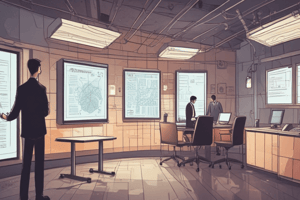Podcast
Questions and Answers
The ____________ module manages the acquisition of raw materials from suppliers.
The ____________ module manages the acquisition of raw materials from suppliers.
Materials Management (MM)
The ____________ module maintains production information and schedules.
The ____________ module maintains production information and schedules.
Production Planning (PP)
The __________ module plans and records quality control activities.
The __________ module plans and records quality control activities.
Quality Management (QM)
The ___________ module manages maintenance resources and planning for preventive maintenance.
The ___________ module manages maintenance resources and planning for preventive maintenance.
The ________________ module helps manage fixed-asset purchases and related depreciation.
The ________________ module helps manage fixed-asset purchases and related depreciation.
_____________ help companies streamline their interactions with customers.
_____________ help companies streamline their interactions with customers.
____________ means releasing the documents that the warehouse uses to pick, pack, and ship orders.
____________ means releasing the documents that the warehouse uses to pick, pack, and ship orders.
____________ is the amount of the bars that can be produced.
____________ is the amount of the bars that can be produced.
_______________ programs are core software used by companies to coordinate information in every area of the business.
_______________ programs are core software used by companies to coordinate information in every area of the business.
____________ is a collection of activities that takes one or more kinds of input and creates an output, such as a report or forecast, that is of value to the customer.
____________ is a collection of activities that takes one or more kinds of input and creates an output, such as a report or forecast, that is of value to the customer.
A shortfall is called a __________ if data are inaccurate or not current.
A shortfall is called a __________ if data are inaccurate or not current.
To avoid stockouts, management might carry extra raw material and packaging, known as ___________.
To avoid stockouts, management might carry extra raw material and packaging, known as ___________.
___________ includes the computers, people, procedures, and software that store, organize, and deliver information.
___________ includes the computers, people, procedures, and software that store, organize, and deliver information.
____________ are analyses that attempt to predict the future sales of a product.
____________ are analyses that attempt to predict the future sales of a product.
___________ recruits, hires, trains, and compensates employees, ensures compliance with government regulations, and oversees the evaluation of employees.
___________ recruits, hires, trains, and compensates employees, ensures compliance with government regulations, and oversees the evaluation of employees.
The ____________ module records sales orders and scheduled deliveries.
The ____________ module records sales orders and scheduled deliveries.
_____________ is the process of developing a prediction of future demand for a company's products.
_____________ is the process of developing a prediction of future demand for a company's products.
_____________ is the process of breaking down the production plan into finer time units.
_____________ is the process of breaking down the production plan into finer time units.
______________ began in 1977 as Software Development Laboratories (SDI).
______________ began in 1977 as Software Development Laboratories (SDI).
______________ uses demand management's production plans as an input for a production schedule.
______________ uses demand management's production plans as an input for a production schedule.
______________ determines the amount and timing of raw material orders.
______________ determines the amount and timing of raw material orders.
______________ is a list of the materials needed to make a product.
______________ is a list of the materials needed to make a product.
_____________ refers to the process of determining production quantities for raw materials produced in-house.
_____________ refers to the process of determining production quantities for raw materials produced in-house.
_______________ describes all activities that occur between raw materials and finished products on the store shelf.
_______________ describes all activities that occur between raw materials and finished products on the store shelf.
Flashcards are hidden until you start studying
Study Notes
Enterprise Resource Planning (ERP)
- ERP programs are core software used by companies to coordinate information across all business areas.
- Business processes involve taking various inputs to produce outputs valuable to customers.
- A stockout occurs when a company runs out of raw materials or packaging due to inaccurate or outdated data.
- Safety stock is an extra amount of raw materials and packaging kept to prevent stockouts.
- Information systems (IS) encompass computers, people, procedures, and software for storing, organizing, and delivering information.
- Sales forecasts help predict the future sales of a product.
- Raw data refers to unprocessed numbers collected from operations.
- Marketing and Sales departments set prices, promote products, take orders, provide customer support, and create sales forecasts.
- Scalability allows for increasing a system's capacity by adding hardware when needed.
- PeopleSoft was founded by David Duffield.
- Supply chain management involves planning production, ordering raw materials, receiving materials, manufacturing products, maintaining facilities, and shipping products to customers.
- Accounting and Finance departments handle financial accounting, manage accounts, plan and budget, and manage cash flow.
- Human resources (HR) departments recruit, hire, train, compensate employees, ensure regulatory compliance, and oversee employee evaluations.
SAP ERP Modules
- The Sales and Distribution (SD) module records sales orders and scheduled deliveries.
- The Materials Management (MM) module manages raw material acquisition from suppliers, inventory handling, and finished good shipping.
- The Production Planning (PP) module manages production information, planning, scheduling, and recording production activities.
- The Quality Management (QM) module plans and records quality control activities like inspections and certifications.
- The Plant Maintenance (PM) module manages maintenance resources and plans preventive maintenance to minimize equipment breakdowns.
- The Asset Management (AM) module manages fixed asset purchases and depreciation.
- The Project System (PS) module plans and controls new R&D, construction, and marketing projects.
- The Financial Accounting (FI) module records transactions in the general ledger.
- The Workflow (WF) module automates activities within SAP ERP.
- The Controlling (CO) module assigns manufacturing costs to products and cost centers for profitability analysis.
Key Concepts
- Return on Investment (ROI) measures an investment project's value by dividing its benefits by its cost.
- Delivery refers to releasing warehouse documents for picking, packing, and shipping orders.
- Pricing involves determining pricing strategies for different customers.
- Customer Relationship Management (CRM) helps companies streamline customer interactions.
- Capacity represents the maximum output a company can produce.
- Standard costs are normal manufacturing costs calculated from historical data and adjustments.
- Sales Forecasting involves predicting future demand for a company's products.
- Sales and Operations Planning (SOP) determines what a company will produce.
- Demand Management breaks down the production plan into finer time units to meet individual product demand.
Other Key Concepts
- Oracle, founded in 1977, is a major software company.
- Detailed Scheduling uses demand management's production plans to create a production schedule.
- Production uses the detailed schedule to manage daily operations, determining what to produce and staffing requirements.
- Materials Requirements Planning (MRP) determines the amount and timing of raw material orders.
- Rough-cut Planning is a general term for aggregate planning in manufacturing.
- The Master Production Schedule (MPS) is the output of the demand management process.
- A Bill of Material (BOM) outlines the materials and quantities needed to make a product.
- Lead Time is the cumulative time for a supplier to deliver an order from receipt to delivery.
- Lot Sizing refers to determining production or order quantities.
- Repetitive Manufacturing involves production lines switching between similar products.
- Supply Chain encompasses all activities from raw material origins to product availability on shelves.
- Initial fill rate is the percentage of an order fulfilled in the first shipment by a supplier.
- Metrics refer to performance measurements.
- SAP ERP software was previously known as R/3.
Studying That Suits You
Use AI to generate personalized quizzes and flashcards to suit your learning preferences.




